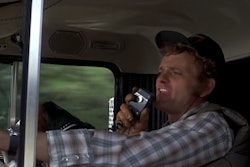“It has become too competitive out here for owner operators.”
– owner-operator Mitchell Maness
If you’ve hung on to your truck during the past three years – a period of economic upheaval, fuel volatility and bankruptcies – you better hang onto your hat, too. Although nothing’s certain in the world of economic forecasting, some analysts think 2004 might be the comeback year for owner-operators. Most, at least, are willing to predict better times and better pay than in the past three years.
The reasons are plentiful:
Even fuel, which has fluctuated wildly over the past three years, seems to be stabilizing. Since May 1, retail diesel prices have stayed at or below $1.50.
“There are definitely signs of the economy getting better for owner-operators,” says Todd Amen, whose American Truck Business Services serves thousands of owner-operators. “The data on our drivers and fleets indicate October was the strongest month we’ve had in a long time. We’re looking forward to a strong year next year for freight.”
“I think that 2004 is going to be a better year,” says Danny Mills, an owner-operator leased to Ozark Motor Lines. Mills, who is from Marshall, Texas, says he hopes a better economy translates to better pay, too. “If business improves, we’ll get more miles.”
Of course, this rosy scenario is by no means guaranteed. “You have economic growth that is probably overstated,” says Bob Delaney, a freight analyst with Cass Information Systems, which processes invoices for fleets and shippers. “Then you’ve got all this build-up in services and retail. But manufacturing is just starting to come back. Some of the truckers are doing well. Others are cautious. Nobody is throwing any parties right now.”
Delaney says the big question remains manufacturing, which accounts for most freight. Manufacturing grew at a fast pace as late as November – its best month in 20 years. But analysts caution that if manufacturing, which has been the weakest link in the U.S. economy for the past three years, fails to sustain its current growth, freight availability may follow.
Owner-operators such as Mitchell Maness of Collins, Miss., are also not convinced that 2004 will be a turnaround year. “I may see a drop of 25 percent in my business,” says Maness, who is leased to Cresco Lines. He blames changes in the hours-of-service rule, stepped-up law enforcement, new commercial driver’s license rules and shifts in the flatbed business. “It’s become too competitive out here for owner-operators. It’s hard to keep up. I think we’re going to lose a lot of drivers next year.”
Still, trucking economists are upbeat about 2004, largely because of solid freight. Donald Broughton, senior transportation analyst for A.G. Edwards and Sons, says the recent increase in freight tonnage and lower inventory of used trucks are good signs for fleets and truck and engine manufacturers.
“Intramodal and LTL seem to be doing well,” Broughton says. “The only trucking sector that we didn’t see improve in the third quarter (of 2003) was line-haul, but that will change. I believe 2004 and 2005 are going to be good years.”
Other positive predictions are based largely on broader economic growth. In the third quarter, the gross domestic product, the broadest measure of the economy, grew 8.2 percent – the largest growth in GDP since 1984. The economy is being pushed by a combination of low interest rates, tax cuts and a weak dollar, which has increased exports.
“Next year is going to be a pretty good year,” says Ken Kremar, director of capital goods and freight transportation for Global Insight. “Economic growth will be around 3 percent for 2003. We think it will be somewhere north of 4 percent for 2004. The trucking industry should do pretty well.”
With improvements in manufacturing activity driving shipments of raw materials and finished goods, there should be an abundance of freight, Kremar says. Retail and wholesale inventories are also at low levels and should spur loads if the economy percolates as analysts predict. The last year the economy grew at a level above 4 percent, 1999, was a bellwether year for trucking companies, Kremar says.
Truckers may also find some relief in 2004 from fuel costs. The price of diesel has been relatively stable since May and nothing on the horizon looks likely to cause a major spike, says Brad Simons, vice president of fuel provider Pathway Network. “If we assume world peace, the fundamentals are there for a stable year,” he says.
Peace has been hard to predict since the Sept. 11, 2001, terrorist attacks, with the U.S. entering two major conflicts in the oil-rich Middle East in the last two years. But conflicts in Afghanistan and Iraq are already part of the market’s calculations, and with no additional major military action on the horizon, fuel analysts are starting to breath easier. They say truckers interested in fuel prices should instead pay attention to weather and the growing economy.
If winter is mild or at least no worse than predicted, diesel prices could fall because heating oil inventories are at solid levels. Heating oil demand often affects the price of diesel because the two fuels are closely linked. As for the economy, the accelerated growth that could lift truckers out of three sluggish years might hurt fuel prices if demand for diesel outstrips supplies.
“The projection is that winter is going to be cold and the economy will be good, which should increase prices,” Simon says. “But current prices are artificially high right now.” That means the market has already taken into account those possibilities, and barring another unusual event like a large-scale terror attack, swings in the price of diesel should be minor, Simon says.
Finally, if the year is good for the industry, it should be good for owner-operators – especially in the short run, analysts say.
“Owner-operators should improve their bottom lines,” says Gordon Klemp, president of Signpost and publisher of the National Survey of Driver Wages. Carriers hedging their bets on equipment purchases for the next year are instead hiring owner-operators. Those with their own equipment are in high demand, Klemp says.
Kremar agrees, noting that fleets are still wary about economic improvement. “If they’re not willing to commit their own equipment, then they’re going to turn to owner-operators,” he says. “Now is the opportunity for owner-operators. This is probably the best time owner-operators have had in three years.”
HOURS RULE, ECONOMY PUSH BIG FLEETS TO GIVE BIG RAISES
Several major carriers are ringing in the New Year with compensation hikes that could mean thousands of dollars for drivers.
Raises are as high as 6 cents a mile. Some fleets are adding or improving bonuses and pay for stoppage and detainment, commonly referred to as accessorial pay.
Fleets cite two reasons for the increases: the new hours of service rule and demand for drivers. Schneider National says its raises – which could amount to as much as $3,500 a year for some owner-operators – are based on retention and recruitment.
“We’re seeing a surge in the demand for drivers today,” says Schneider spokesman Mike Norder. “That demand is starting to outstrip available drivers. We’re positioning ourselves to retain the very best drivers.”
Schneider raised pay for solo owner-operators two pennies, to 86 cents a mile; company drivers got a boost of 1 to 2 cents per mile, including improved stoppage and detention pay, while team drivers and owner-operators faired even better.
Other fleets say the raises will compensate drivers for lost productivity due to changes in the hours-of-service rule. “This is an industry wide-challenge,” says Russell Gerdin, president and CEO of Heartland Express, which gave all mileage-based drivers a 3-cent-per-mile raise. A top solo driver will now earn 43 cents a mile; an owner-operator will earn 88 cents. Raises will be staggered across the first quarter of 2004. “The driver cannot bear the brunt of this from a financial and a production standpoint.”
But some drivers will bear the brunt despite the raises, says Gordon Klemp, president of Signpost and publisher of the National Survey of Driver Wages. “If it weren’t for hours of service, these raises would be a great deal,” Klemp says. But estimated losses in productivity, due to less driving time in most situations, could more than offset driver gains. “We’re less optimistic that there will be an improvement in take-home pay.”
Klemp says carriers’ predictions of 2 percent to 20 percent productivity losses will be felt directly by owner-operators and company drivers in terms of lost miles. But owner-operators who drive the same miles as they did in 2003 or who can take advantage of productivity gains under the new rule stand to increase miles and will take home more money.
Other fleets big and small are sure to raise pay as well as the demand for drivers increases. “Expect more announcements soon,” Klemp says.
Here are terms from some fleets that increased compensation:










